We can organize our drawing process by focusing on well-defined chunks of information at each step of completing a drawing. Rather than simply trying to mimic what we see, we can approach drawing conceptually by organizing these tasks around separate bits of visual information. We can use conceptual frames of reference to understand what we are drawing.
One way one frame of reference we can use is to identify the underlying structure of our subject and draw that first. If we can learn to identify the underlying structures, we draw we will improve our ability to draw more accurately. Our accuracy improves because we can lay out some fundamental features of our subject matter correctly before investing time in the details.
A great approach to identifying and drawing the underlying structure is to illustrate that structure in simple or basic forms. Let's look at why this is and how to do it.
The above video explains the simple forms, why we use them, and demonstrates drawing an object using the simple forms to set up the underlying structure.
The Simple Forms
The simple forms are basic geometrical forms. These forms are three-dimensional objects with the least amount of shape complexity.
These forms are the box, sphere, cylinder, cone, and pyramid.
We use these forms like building blocks to construct the underlying structure before drawing the contours and details.
Why Draw using Simple forms?
When we identify and draw the simple forms, we reduce the amount of visual information we are focused on when we start a drawing. We are simplifying what we need to understand about our subject, in the beginning, by ignoring everything but the basic shapes of the forms we see. This simplification allows us to focus on a few essential structural components, such as the scale of the subject matter, proportions of its parts, placement of the elements within the drawing.
The benefits of working on those essential elements by drawing the simplified forms are:
- Our drawings are more accurate.
- We draw faster.
- We are not relying on mimicking or copying the reference material.
Our drawings become more accurate as we are now thinking about the three-dimensional structure of the subject matter. If we focus on the surface contours and details but not the forms, we might miss something and accidentally create a distorted feature in the drawing. If we can translate what we see into simple forms, we will have a more comprehensive understanding of our subject.
We will save time as we will not have to make as many corrections and adjustments to our drawings. This idea may seem counterintuitive because we might be adding a step to our drawing process, but it does save us time. We save time by working out the deeper structural elements before investing time in the details.
For example, imagine drawing a person. We start drawing the head and finish at the feet, working on all the contours, details, and shading along the way. If we did not think about the scale or the placement of the figure when we start to draw that person, we might find the drawing won't fit on the page. We can't place the feet on the page. We accidentally cropped the figure. Since we were drawing the whole figure, we now have to start over. However, if we sketch the figure using simple forms first, we can make sure that the entire body, from head to toe, will fit.
We can also break away from relying on a reference. Though there is nothing wrong with using reference material, it is not always necessary or practical. We can start to make up our subjects from the imagination, using simple forms to explore the structures of these imagined things.
We might want to use a reference image, but we feel we need to modify the object's appearance within the drawing. Understanding the underlying structure through simple form makes it easier to adapt the look to meet our needs.
Try it
The best way to see how this works is to try this technique. It can be challenging at first, but you will begin to see the benefits of identifying and drawing the simple forms with some practice.
The above video demonstrates drawing an object using this technique. After watching the demonstration in the video, give it a try.
Pick something to draw. Then translate and draw the underlying forms you see within that object into simple forms. It takes some practice, and it is easier to do this with less structurally complex subjects. Start with objects where you can readily see the simple forms within the object. Then gradually practice drawing the simple forms of more complex subject matter.
If you would like to use the same reference image used in the demonstration, click on the link below.
Reference photo of water jug from the demonstration





